Berets: types, materials and colors
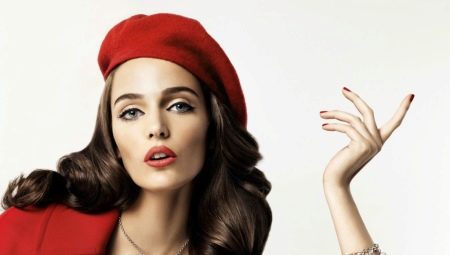
Some hats, despite their rich history, remain popular to this day and regularly decorate modern men's and women's bows on the covers of glossy magazines. In this article, you will learn about the key varieties of berets, as well as find out what materials and colors are used to create these stylish hats.
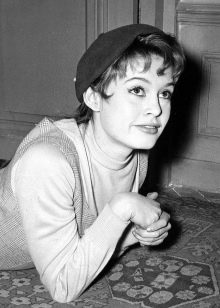
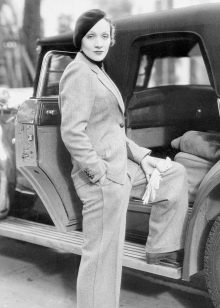
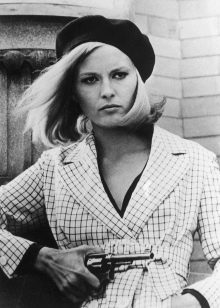
What it is?
Beret (or beret) is soft and flat headdress of round or oval shape without brim, band and visor... Translated from the French language, the beret literally translates as "Basque cap" or cap.
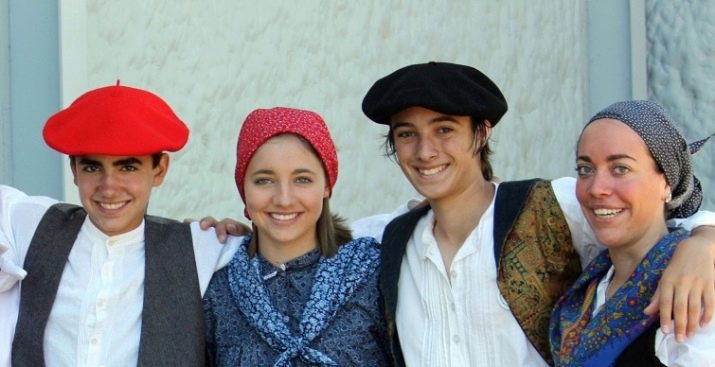
Today this headdress is considered a popular element of both women's and men's bows. Berets are made mainly of expensive natural fibers and fabrics (natural leather, suede, fur, silk, felt) and can be seasonal or demi-season, sewn or knitted.

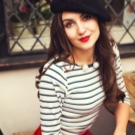
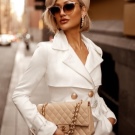
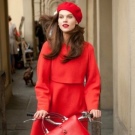

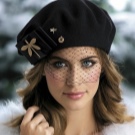
In modern women's bows, berets are actively decorated with additional decorative elements: rhinestones, brooches, embroidery, veil and even semiprecious minerals.

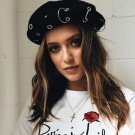
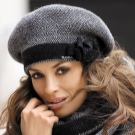
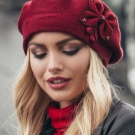

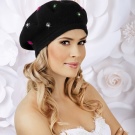
Also in some cultures, the beret is an indispensable part of the uniform in law enforcement and the military... An example of this is the Scottish national costume or military berets of representatives of the Russian Airborne Forces.

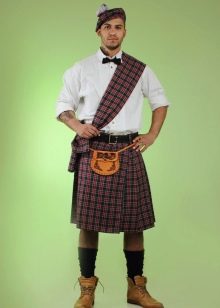

History
Most historians are sure that the prototype of the beret, which is actively used today in the creation of fashionable bows, is the Celtic headdress, which is still included in the traditional Scottish costume.Initially, the beret was carried out mainly in blue, was called "tam-o-shenter" and was a wide and flat headdress with a characteristic bubo on the top of the head.
According to another version, berets were first developed in Ancient Greece. There, these hats were made in certain colors, where each of them corresponded to the social status of a person.
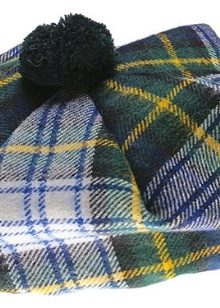

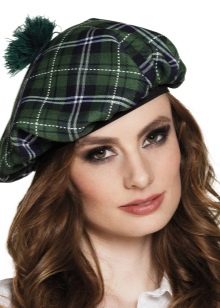
It is especially interesting to observe the history of the popularization of the berets.
- In the Middle Ages such headdresses had a quadrangular shape and were worn exclusively by priests, nobles and royalty (an example of this is Henry VIII Tudor).
- At the end of the 15th century fashion for berets spread among important persons in France and Germany. At that time, berets of a quadrangular shape were also used, but already with the brim raised at the back. Since that time, these hats have been adorned with decorative elements in the form of embroidery, buckles, brooches, hairpins and even ostrich feathers. It is noteworthy that even then berets were widespread among both men and women.
- In the first half of the 16th century berets are firmly entrenched in the Spanish fashion niche. In those years, these hats gradually began to take on a round shape, but were still adorned with feathers and buckles. It was at this time that simplified and laconic versions of berets began to be worn by ordinary citizens.
- The period from the 16th to the 17th centuries was not favorable for the berets. Around this time, the world famous cocked hat appeared, which completely suppressed the fashion for berets. These headdresses remained in the costumes of artists, pages and in the uniform of the Scottish military personnel.
- Early 19th century it became a time of full-fledged revival for berets - these hats became an indispensable part of the ceremonial dress of all European, and a little later, Russian fashionistas. Regarding the shape of the berets, they did not change, however, for the manufacture of such accessories, they began to use exclusively high-quality, bright and expensive fabrics (silk, velvet and brocade), and even precious stones, fresh flowers, satin ribbons and pearls began to be used in their decoration.
- XX century introduced a military background to berets - modified versions of such hats were introduced into the uniforms of the military personnel of France and Britain. After the end of World War II, berets were made from thin and lightweight materials and were often supplemented with embroidery, brooches and even a veil. By the end of the 20th century, berets were firmly entrenched in the iconic image of hipsters and beatniks.
- Since the beginning of the XXI century berets are firmly entrenched in both men's and women's fashion, but they remain an integral part of military suits in countries such as Russia and Scotland.
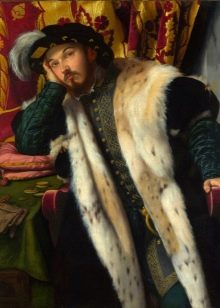
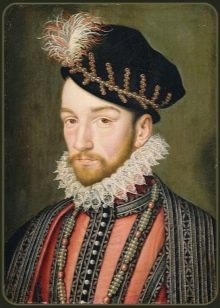
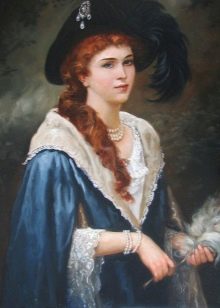
Regularly, berets of some styles become real trends of the fashion season.
Among modern and historical figures, in whose image the beret appeared at least once, the following names can be distinguished: Ernesto Che Guevara, Rembrandt, Auguste Rodin, Bob Marley, Greta Garbo, Dita von Teese and Vanessa Paradis.
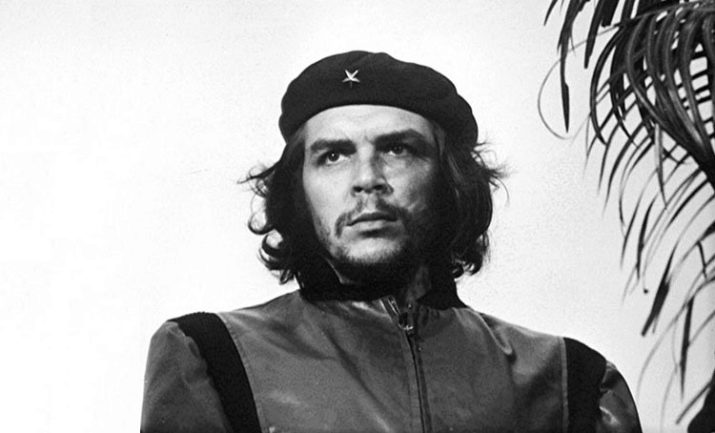

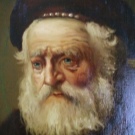
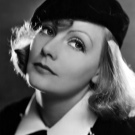
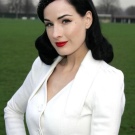
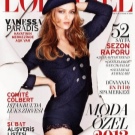
Species overview
There are several popular varieties of berets, depending on the style and manufacturing method. Below we will consider the most common and iconic varieties of berets.
- Knitted berets - the best choice for a warm winter look. Such models go well with down jackets, coats and some fur coats. They are characterized by large sizes, loose fit, and, as a rule, are complemented by original patterns or floral patches. Models of berets made of knitted wool are especially popular today.
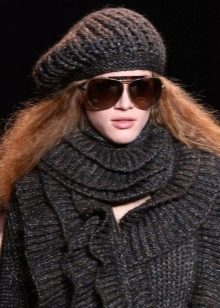


- Felt or tweed berets - a classic version that will simultaneously save your head from cold wind and frost and will be in harmony with the rest of the clothing. Such products look laconic, stylish and rich, and therefore they look best in a sophisticated weekend bow.
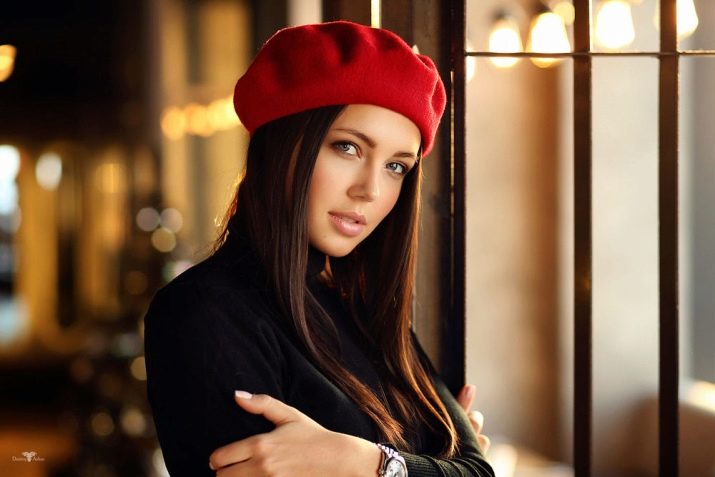

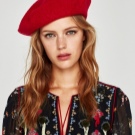


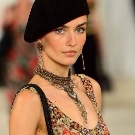
- Beret with a veil (or simply "pill") refers to evening headdresses - in the bow of a modern girl, this option can become a real highlight that will effectively refresh the whole image. This type of beret has a sophisticated shape, is made of thin and dense natural materials and is necessarily decorated with a veil that can hide the eyes or simply decorate the product.
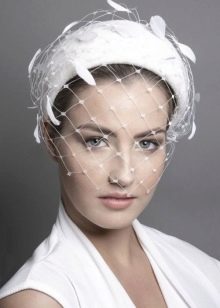

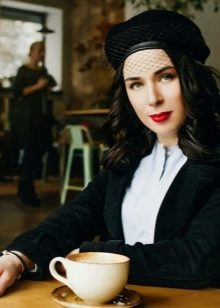
- Models with bubo or pompom. Such berets have one characteristic feature - a woolen or naped bubo, which is usually located at the very top of the beret. The pompom is a purely decorative element and does not perform any additional tasks.
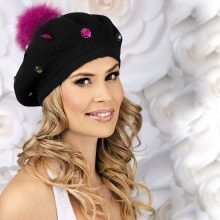
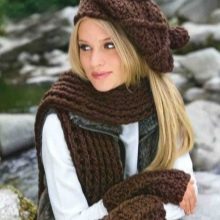

- French beret. It is believed that it was from these models of berets that the fashion for flat and round hats began. Once such berets were characterized as a revolutionary symbol and were used exclusively by men, only then these stylish headdresses began to be worn by French girls.
Until now, classic black berets are considered a typical symbol of France and everything romantic.
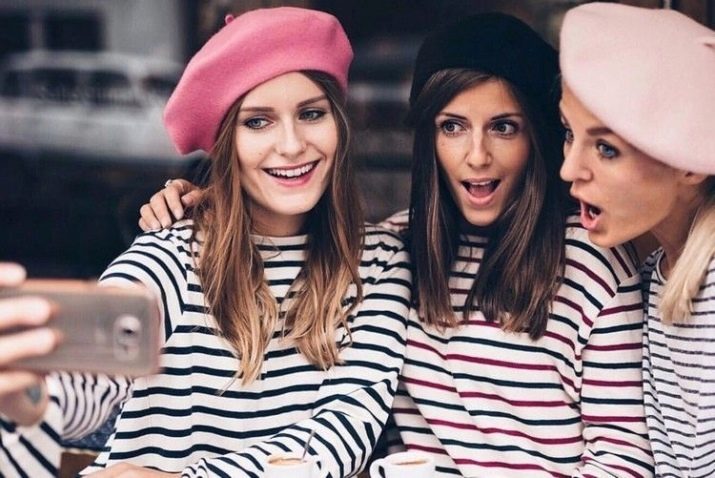
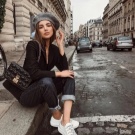
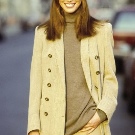
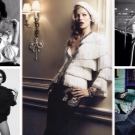
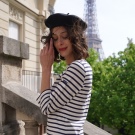
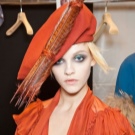
- Scottish beret. These headdresses in their homeland were called "balmoral" - in honor of the name of the residence of the English kings in Scotland. Balmoral is still part of the Scottish national costume to this day. Distinctive features of such a beret can be considered a characteristic pompom on the top of the head, as well as two dark silk ribbons, which are tied in a neat knot and hang down from the back of the product.
In addition, the underside of such berets is usually painted in the traditional white-red-black check. Modern balmoral is usually performed in dark blue. A characteristic feature of such a beret is the upper part tilted to the right.
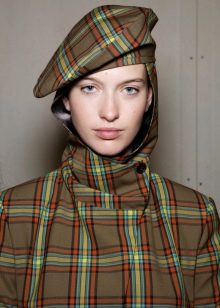
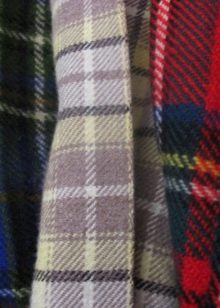
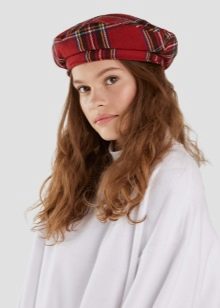
- Army berets. This group includes seamless and stitching berets worn exclusively by members of the military. These berets can be executed in black, green, red, camouflage or blue, depending on the type of armed structure. Characteristic differences: the upper part inclined to the right (in rare cases to the left) side, while the front side of the beret is decorated with stripes, emblems or badges indicating belonging to a particular military structure.
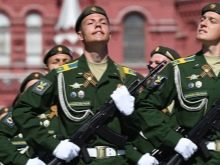
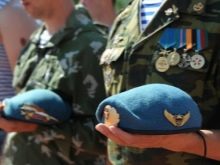

Among such hats, there is no clear division into male and female models, however, products for men are usually strict berets with a seam, made in darker or neutral colors.
Besides, male models are sometimes complemented by a characteristic visor. As for children's berets, these hats are usually not intended for boys, but models for girls differ little from adult options, except that they are created, first of all, from warm and practical materials.
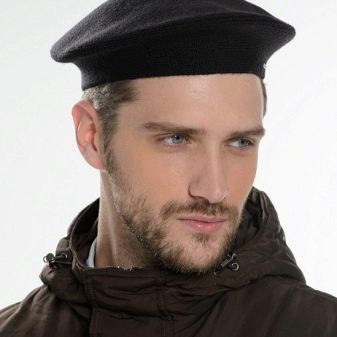
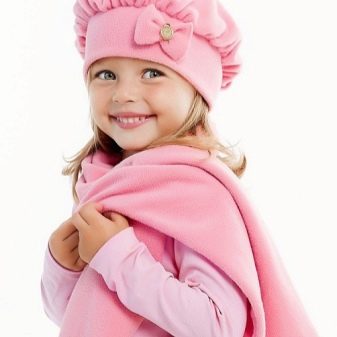
Materials (edit)
All berets, depending on the style, purpose and seasonality, can be created from different materials. Usually, when creating such hats, only natural and expensive materials are used.
- Woolen models. To create such berets, sheep, angora or merino wool are used. The main advantage of woolen products is excellent heat retention, resistance to dirt and shrinkage.
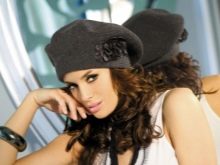
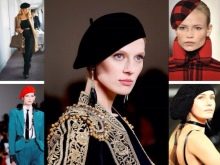
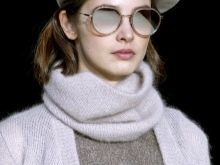
- Felt berets... These models can also be classified as woolen, but here the woolen fibers are not made in the form of yarn, but in the form of layers created using the felting technique. Unlike ordinary wool, felt is considered denser and more reliable, it does not let the wind through, does not stretch, and felt hats have a more contoured shape.
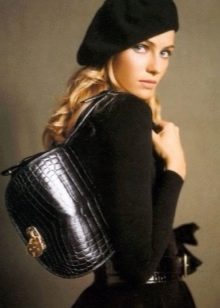
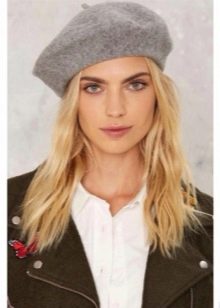
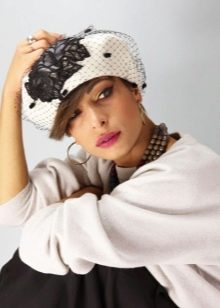
- Suede leather. This material is a soft leather with a velvety and delicate surface, which is created using the fat-tanning method from the skins of animals such as deer, elk, sheep or goat. The advantage of suede is excellent heat retention, wind protection, resistance to deformation and shrinkage, as well as a chic appearance.
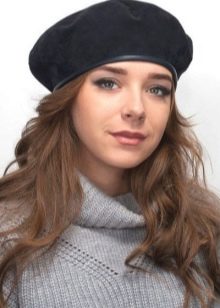
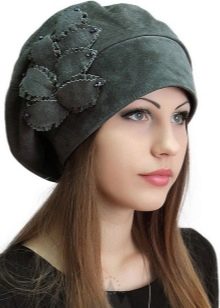
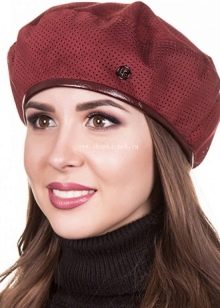
- Leather it is usually used in sewing hats according to patterns, where it is necessary to provide a certain shape. Leather products do not look good in every look, but they are able to create a stylish and even shocking look with the same leather clothing.
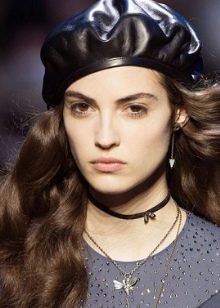
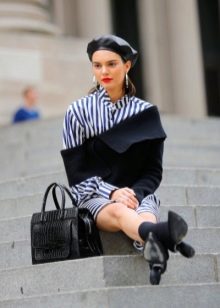
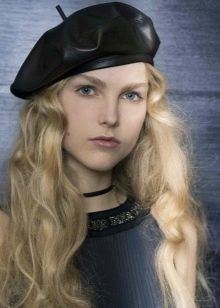
- Cotton products. This includes models of berets made from fabrics and yarns. Cotton is a natural and versatile material that performs well in any weather and at any time of the year. In addition to a pleasant appearance, cotton hats do not cause allergies, absorb moisture well and let air through perfectly. Cotton fibers are found in modern materials such as corduroy, satin, matting, jeans and twill.
It is especially knitted versions of cotton berets that look especially interesting in an autumn or winter bow.

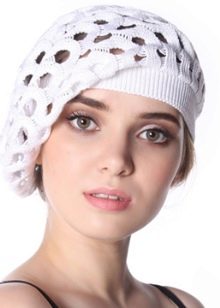

- Mohair models... This material is processed wool of angora goats and is used to create only expensive hats, dresses, coats, suits, as well as bedspreads, blankets, toys and even socks. Mohair is characterized by good strength, light weight, soft and pleasant surface, as well as fire and wear resistance.
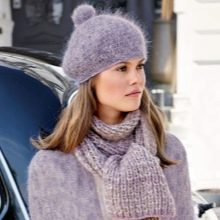
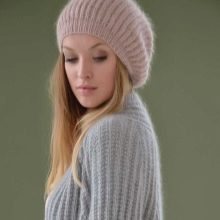

- Mink products. Mink is one of the most popular and not the most expensive furs in the world. Some fashion designers call this material the "queen of furs". In addition to a chic appearance, mink products have a lot of advantages: wear resistance, excellent heat retention, softness, a large selection of shades, plasticity of fur, and versatility. Fluffy mink berets can look harmonious in almost any modern look.

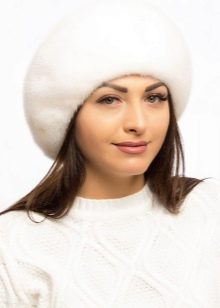
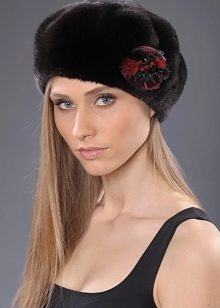
Colors
In the current fashion season, almost any color scheme is allowed. The main thing is that the beret matches the color type of the person who wears it. Also, experts do not recommend using products of flashy and acidic shades. Leopard berets are at the peak of popularity today - they are ideal for girls who are not afraid of prints in clothes. Below we will consider the colors and shades that are most often used today to create fashionable and stylish berets.
- Yellow... Some experts advise against using shades of yellow in the creation of hats, since yellowness can negatively harmonize with the color type of the face. At the same time, wheat and discreet sunny shades in almost any bow will look warm and elegant. Soft yellow shades go well with blue and purple outerwear.

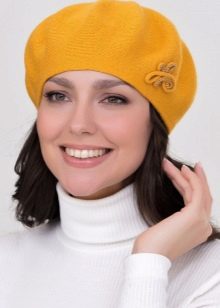
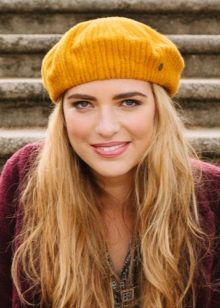
- Red... Burgundy and delicate cherry shades can be a spectacular accent throughout the look. The uniqueness of red berets is that they can be the only red thing in a bow, while being able to create a pleasant contrast with the rest of the clothing. To make the red beret look not too flashy, you can balance it in the bow with a burgundy scarf or handbag.
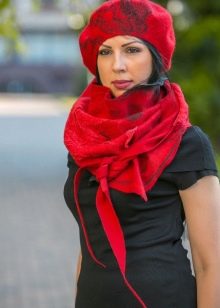
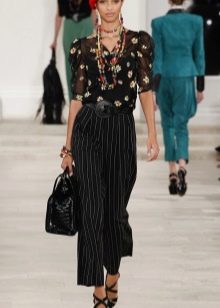

- Black headdress - a permanent classic that will never lose its relevance. Products of these colors, perhaps, will not become the main accent of your bow, but they will definitely be in harmony with the overall color scheme. The combination of a black beret with leather goods is especially interesting. Also, a bow with black berets can be effectively complemented with round glasses, burgundy or scarlet lipstick. Best of all, a black beret will be combined with leather jackets and leather trench coats in an ensemble with a dark turtleneck and a knee-length woolen skirt.
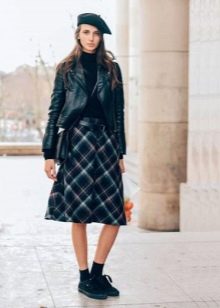
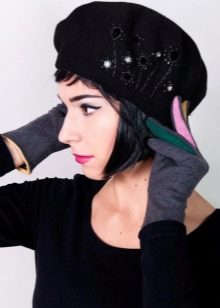

- Beige, cream and caramel shades can also be considered versatile in clothing. They are combined with most other shades (blue, black, gray, lilac, wheat, green) and at the same time give the onion confidence, calmness and charm. Such shades look especially interesting in the autumn season, in harmony with golden falling leaves. Berets of these colors are chosen by men and women who do not want to stand out in the crowd.
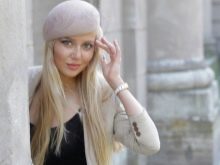
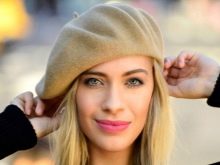
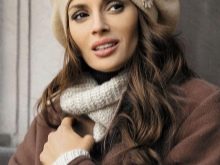
- Berets of white and light colors... White is considered by many to be impractical, but it is completely versatile and elegantly fits into any look. Light colors will never go out of fashion, and therefore a beret in the image of a girl will always look not only harmonious, but also fashionable. Such a bow can be effectively decorated with a black or blue polka-dot dress or accessories in the form of a strap and a brooch.
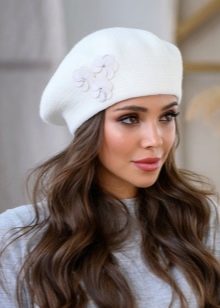
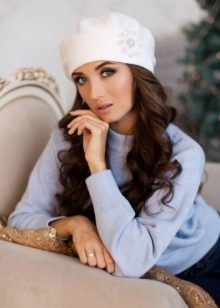
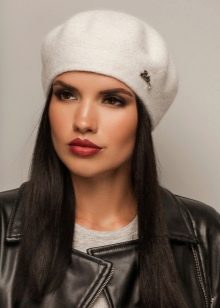
- Blue colors and shades of sky colors. In women's headdresses, blue colors are usually used, close to indigo, sapphire, azure, but in men's models, blue is used exclusively when creating military berets (like in the Airborne Forces).
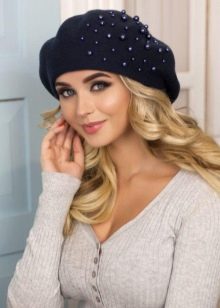
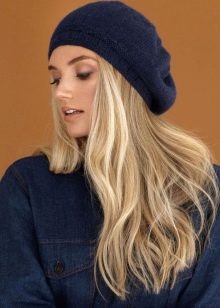
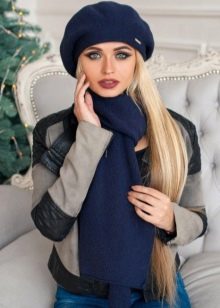
- Complex colors. These include models of berets of rarely used shades or models with prints. In order for such products to be in harmony with the bow, it is recommended to complement them with accessories (glasses, scarf or earrings) of the same color.
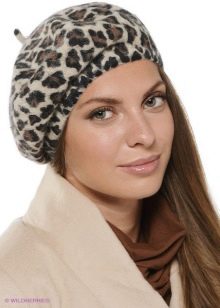
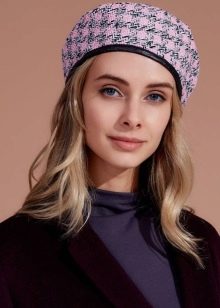
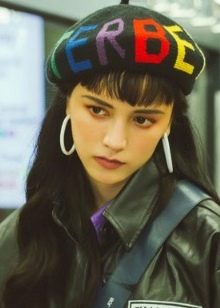
How and with what to wear?
The choice of clothing for a newly purchased beret depends on several factors. First of all, this is the chosen style of clothing, then the season (depending on whether you have chosen a model for autumn, spring or winter), and only then the color scheme. Below will be brief recommendations for the inclusion of such a headdress, such as a beret, in everyday female and male looks.
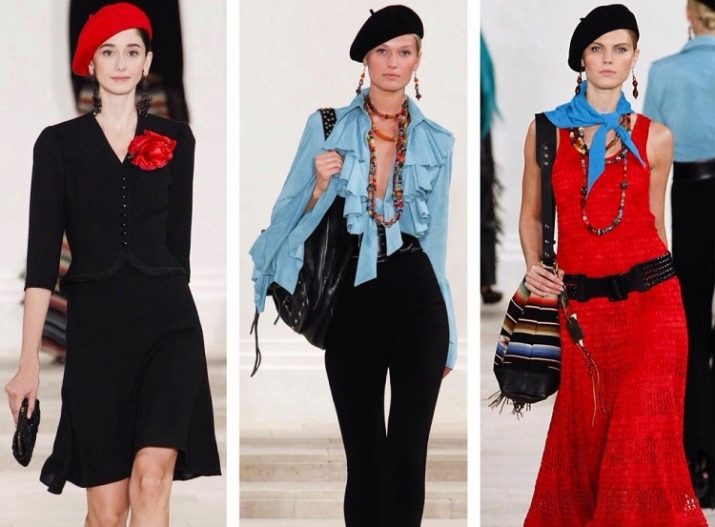
Man
Berets are usually used by creative and extraordinary people who want to stand out from the crowd or are immersed in some unusual activity. Also, do not forget about military berets, which are still an indispensable part of the uniform of law enforcement officers. In the case of using men's berets, there are not many recommendations.
Such hats are suitable exclusively for a certain image or style of clothing. Obviously, in an ensemble with a beret, sporty and strict clothing options will look inappropriate. Best of all such hats go well with casual clothing. This can include ripped jeans, loose-fitting sweaters, wool scarves, coats and raincoats.
The key feature of men's models of berets from women's is that male options are usually made in more neutral, discreet and dark colors: brown, black, deep blue, caramel.


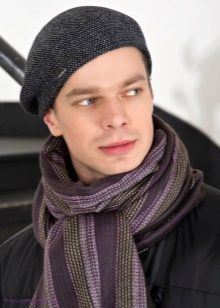
Woman
The beret cannot be considered a completely traditional and universal headdress, and therefore girls who wanted to include it in their image, should consider a number of the following recommendations from fashion experts.
- Curls. The first rule is that you cannot remove your hair completely under the beret, regardless of whether you have long strands or not. Curls gently knocking out from under the beret will smooth out facial features and bring more femininity and tenderness to the image. Berets with casual low tufts of hair or with a smoothly combed low tail will look especially interesting. Berets in an ensemble with a woman's hairstyle are considered a classic option - this combination first became popular in France and is still used by many sophisticated women of fashion.


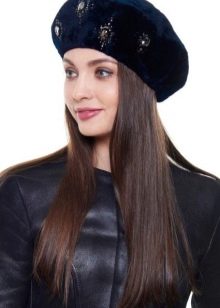
- Features of the structure of the face. So, for girls with a round oval face, it is recommended to slightly move the beret back, while the loose curls visually stretch the face. Women with square and triangular facial contours and clear features need to adhere to asymmetry, which will make the image softer and more feminine. To do this, it is enough to slightly shift the beret to one side and use an oblique bang.
A slightly more forward-shifted beret can visually reduce the size of the forehead, but this technique is unacceptable for girls with wide cheekbones - this will only visually increase the size of the upper part of the face.
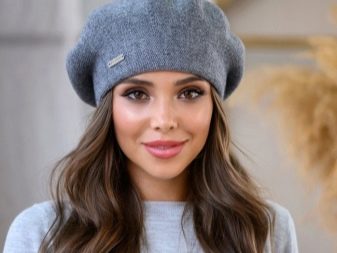

- Beret position. There are some rules that relate specifically to the location of the beret on the head. So, the beret should not cover the forehead by more than half, and its center, ideally, should be located closer to the back of the head, so as not to visually increase the oval of the face. When using a beret, the ears should be covered on both sides - preferably at least halfway.Options with one covered ear will look out of place and childish.
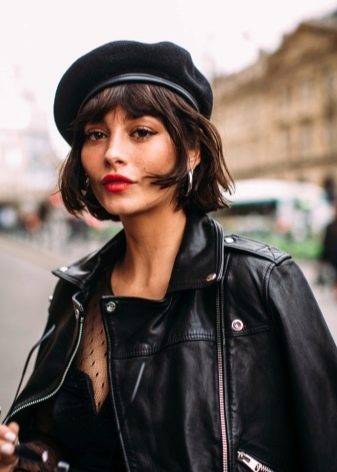
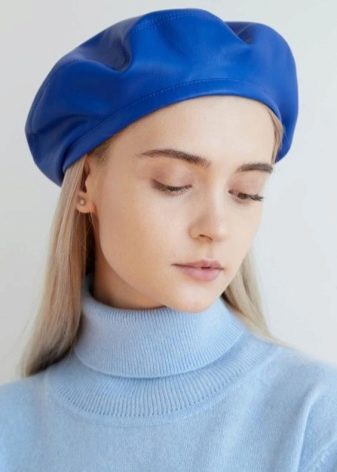
- Advice... Fashionistas use regular clips and hairpins to secure the beret to their hair. In this case, the headgear will not be able to fly off under the gusts of strong winds or damage the styling.
Owners of oval faces can experiment with any position of the beret - there is a high probability that each will look good in their bow.











